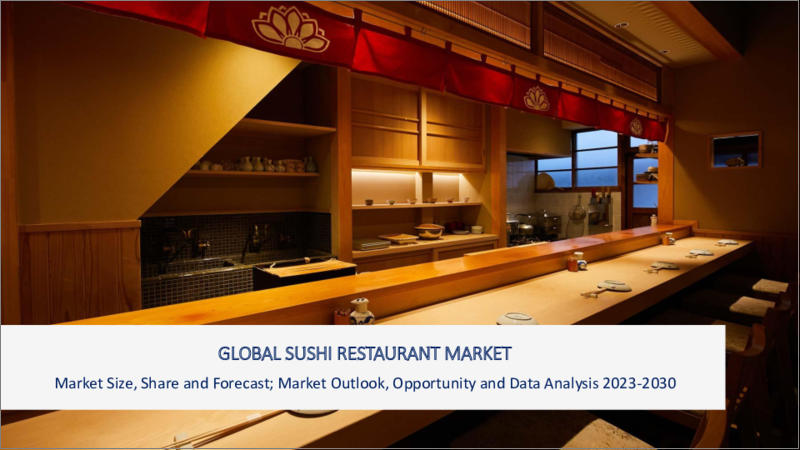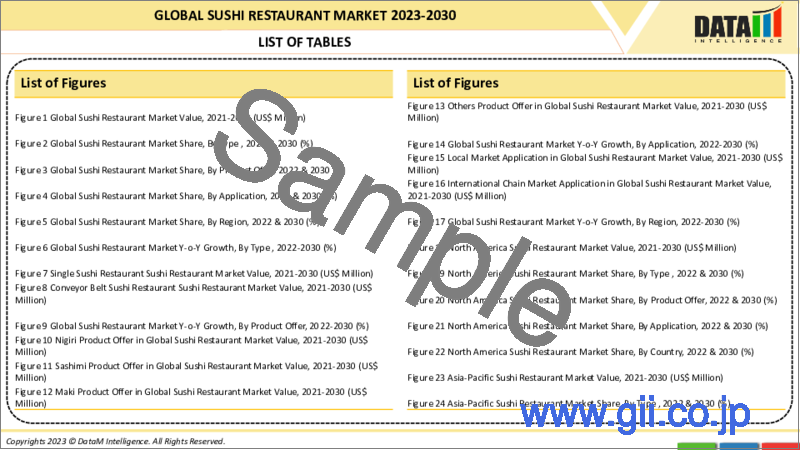|
|
市場調査レポート
商品コード
1136891
寿司レストランの世界市場-2022-2029Global Sushi Restaurant Market - 2022-2029 |
||||||
|
● お客様のご希望に応じて、既存データの加工や未掲載情報(例:国別セグメント)の追加などの対応が可能です。 詳細はお問い合わせください。 |
|||||||
| 寿司レストランの世界市場-2022-2029 |
|
出版日: 2022年10月13日
発行: DataM Intelligence
ページ情報: 英文 170 Pages
納期: 即日から翌営業日
|
- 全表示
- 概要
- 目次
市場力学
マーケティング戦略の強化
一部の外食産業は、広告や製品プロモーションなど様々なマーケティング活動によって売上高を伸ばしており、それに伴い消費者はFacebookやTwitterなどのソーシャルネットワーキングサイトに多大な投資をしています。クイックサービスの寿司レストランなどの商業ベンダーは、ブランドの認知度を高めるためにTwitterを利用し、ベンダーは電子メディアや印刷物を通じてブランドや製品を宣伝しています。インスタグラムでは、受け手の注目が主に写真に集まるため、レストランはソーシャルメディアサイトで人気を集めるために、レストランが雇ったプロのカメラマンが撮影した写真を載せ、キャンペーンや料理の写真を投稿し、顧客エンゲージメントも高めています。
さらに、回転寿司から他の食品まで様々な寿司商品があることも、寿司レストランの商品の売上を伸ばすのに役立っています。顧客受容性の高まりに伴い、寿司レストラン市場は予測期間中、健全な成長率を示しています。これは、セリングポイントの増加、組織小売業者によるより深い浸透、小売チャネルにおけるスペースの増加によって補完されるものです。消費者の多忙なライフスタイルと食習慣の変化は、世界中の寿司レストランメーカーにいくつかの機会を提供しています。
本レポートでは、寿司レストランの世界市場について、約53の市場データ表、40の図表、170ページにわたる情報を提供します。
目次
第1章 調査手法と範囲
- 調査手法
- 市場の範囲
第2章 主な動向と発展
第3章 エグゼクティブサマリー
- タイプ別市場内訳
- アプリケーション別市場内訳
- 地域別市場内訳
第4章 市場の力学
- 市場影響要因
- 促進要因
- 抑制要因
- ビジネスチャンス
- 影響分析
第5章 産業分析
- ポーターのファイブフォース分析
- バリューチェーン分析
- 特許分析
- 規制分析
第6章 COVID-19の分析
- COVID-19の市場分析
- COVID-19以前の市場シナリオ
- COVID-19の現在の市場シナリオ
- COVID-19の後、または将来のシナリオ
- COVID-19の中での価格ダイナミクス
- 需要-供給スペクトラム
- パンデミック時の市場に関連する政府の取り組み
- メーカーの戦略的取り組み
第7章 タイプ別
- 一軒家の寿司レストラン
- 回転寿司
第8章 アプリケーション別
- ローカル市場
- 海外チェーン店市場
第9章 地域別
- 北米
- 米国
- カナダ
- メキシコ
- 南米
- ブラジル
- アルゼンチン
- その他の南米地域
- 欧州
- ドイツ
- 英国
- フランス
- スペイン
- イタリア
- その他の欧州地域
- アジア太平洋地域
- 中国
- インド
- 日本
- オーストラリア
- その他アジア太平洋地域
- 中東・アフリカ地域
第10章 競合情勢
- 競合シナリオ
- 競合他社の戦略分析
- 市況/シェア分析
- M&A(合併・買収)分析
第11章 企業プロファイル
- Feng Sushi.
- 企業概要
- 製品ポートフォリオと説明
- 主なハイライト
- 財務概要
- Food and Life Companies Ltd.
- Hamazushi Co.
- Innovative Dining Group
- Wasabi Sushi
- Genki Sushi Singapore Pte. Ltd.
- Global Kitchen
- Sushi Bar
- Sushi Hasiri
- Sushi SAN
第12章 DataM
Market Overview
Sushi Restaurant Market was valued at USD YY million in 2021. It is forecasted to reach USD YY million by 2029, growing at a CAGR of 3.12% during the forecast period (2022-2029).
Sushi restaurants refer to the restaurants that serve sushi. Sushi is defined as the type of food that incorporates a type of rice seasoned with vinegar, garnished with raw fish or vegetable. The sushi rolls are one of the most common types of food item served in the sushi restaurants. Vendors advertising their brands and products through electronic and print media, and sushi restaurants are focusing on marketing campaigns because of digitization and related developments along with the rise in tourism sector positively driving the market.
Market Dynamics: Increasing marketing strategies
Some of the food service companies heavily depends on various marketing activities such as advertising and product promotions for increasing their sales volume and along with that consumers are spending significantly on social networking sites such as Facebook, Twitter and others. Commercial vendors, such as quick-service sushi restaurants, use Twitter to increase brand awareness and the vendors advertise their brands and products through electronic and print media. On Instagram, as the recipient attention is focused primarily on photos, restaurants put up pictures that are captured by professional photographers hired by them to gain traction on social media websites and they post promotional offers and photos of the food, which also increases customer engagement.
Moreover, the availability of various sushi products ranging from sushi rools to other food products helps to increase the sales of sushi restaurant products. With the increasing customer acceptance, the sushi restaurant market has a healthy growth rate during the forecast period, complemented by an increase in selling points, deeper penetration by organized retail players, and increased space in retail channels. Consumers' busy lifestyles and changing eating habits offer several opportunities for sushi restaurant manufacturers worldwide.
Market Segmentation: Conveyor belt sushi segment accounted for the highest share in global sushi restaurant market
In the conveyor belt sushi plates serving in the sushi dishes are placed on the rotating conveyor and a small quantity of food is ordered. Special order dishes are usually ordered through labelled cylindrical stands to indicate to indicate that this is a special order. The conveyor belt sushi restaurants offer plethora of sushi to sushi to choose for the customers. The customers are able to choose the dishes or commodities by their seats or at a fixed points easily as the conveyor belt makes the food and objects to rotate through the chains of the conveyor belt. It enables customers satisfaction as dishes that are picked up are generally delicious and surpasses the customers expectations. These factors have positively impacted the growth of conveyor belt sushi.
Geographical Penetration: APAC is the dominating region during the forecast period
APAC is projected to be the dominating region due to the increasing demand for sushi restaurants are highly in traction in the developing countries such as Japan, South Korea, China and other countries. Japan is well known for its unique culture and traditions, many of which are still being preserved and practiced today and the preparation of sushi, perhaps Japan's most iconic and popular dish, respected worldwide for its simple yet technical preparation. A sushi chef in Japan entails a very strict and lengthy process, and is nearly always available to men only and respecting sushi restaurant would ever allow an inexperienced hire to dive right into handling the food along with that laborious training process to become a respected sushi chef in Japan usually takes around ten years. Despite the lack of scientific accuracy supporting such claims, resistance towards female sushi chefs persists and the belief that women have higher body temperatures, their hands are not suited for making sushi. All these factors are propelling the growth of the market in APAC region.
Competitive Landscape:
There are several established participants in the industry and local manufacturers; hence, the market is fragmented. Some major key players are Feng Sushi, FOOD and LIFE COMPANIES Ltd., Hamazushi Co., Ltd., Innovative Dining Group, Kappa Create Co., Ltd., KURA SUSHI USA., Maxim's Caterers Limited., Peace Dining Corporation, Sakae Holdings Ltd., Wasabi Sushi., FOOD & LIFE COMPANIES Ltd., Genki Sushi Singapore Pte Ltd., Global Kitchen, Pisces Sushi Bistro, SUSHI BAR, Sushi Seki, Hinata, FUJI SUSHI, Sushi Hashiri, and SUSHI-SAN. Some of the major key players invested in expanding their business. For instance, in July 2021, Bento by EN has started operating their outlets in munirka and udyog vihar with nutritious flavors and rapidly planning to expand throughout the world to deliver the essence of their Japanese cuisines as berco's chain of Restaurants collaborates with Japanese Food Brand to launch in India by the name of 'Bento by EN' in Delhi and Gurgaon. These are governed by the food ministry and have sterile equipment and kitchens as bento by EN offers a diverse selection of traditional Japanese cuisines, which encompasses all of the country's traditional food items while adhering to all of the major COVID-19 criteria. In July 2018, sushiology offers ready-made and made-to-order sushi and sashimi at its flagship bond street site and a new high-quality take-away sushi restaurant is launching in central london next month, with brand and interiors created with award-winning studio, avocado sweets.
COVID-19 Impact: Negative impact on the global sushi restaurant market
During the COVID-19 pandemic, most people worked from home, and due to government restrictions, hotels and restaurants were closed. Some of the other reasons which led to decrease in sales of sushi restaurant food during the pandemic are the high dependence on self-made food due to the fear of COVID-19 virus and lockdown which forced people not to move out of their houses. Consumers turned to online food preferences for sushi food which led to the closure of the restaurants. However, there was an increasing demand for ready-to-cook sushi packaged food during the pandemic. There is a boost to the sushi resturants globally post the COVID-19 pandemic which is anticipated to grow further in the forecast period.
The global sushi restaurant market report would provide an access to approximately 53 market data tables, 40 figures and 170 pages
Table of Contents
1. Scope and Methodology
- 1.1. Research Methodology
- 1.2. Scope of the Market
2. Key Trends and Developments
3. Executive Summary
- 3.1. Market Snippet by Type
- 3.2. Market Snippet by Application
- 3.3. Market Snippet by Region
4. Market Dynamics
- 4.1. Market impacting factors
- 4.1.1. Drivers
- 4.1.2. Restraints
- 4.1.3. Opportunities
- 4.2. Impact analysis
5. Industry Analysis
- 5.1. Porter's five forces analysis
- 5.2. Value chain analysis
- 5.3. Patent Analysis
- 5.4. Regulatory Analysis
6. COVID-19 Analysis
- 6.1. Analysis of Covid-19 on the Market
- 6.1.1. Before COVID-19 Market Scenario
- 6.1.2. Present COVID-19 Market Scenario
- 6.1.3. After COVID-19 or Future Scenario
- 6.2. Pricing Dynamics Amid Covid-19
- 6.3. Demand-Supply Spectrum
- 6.4. Government Initiatives Related to the Market During Pandemic
- 6.5. Manufacturers Strategic Initiatives
7. By Type
- 7.1. Introduction
- 7.1.1. Market size analysis, and y-o-y growth analysis (%), By Type Segment
- 7.1.2. Market attractiveness index, By Type Segment
- 7.2. Single Sushi Restaurant *
- 7.2.1. Introduction
- 7.2.2. Market Size Analysis, US$ Million, 2020-2029 And Y-O-Y Growth Analysis (%), 2021-2029
- 7.3. Conveyor Belt Sushi Restaurant
8. By Application
- 8.1. Introduction
- 8.1.1. Market size analysis, and y-o-y growth analysis (%), By Application Segment
- 8.1.2. Market attractiveness index, By Application Segment
- 8.2. Local Market *
- 8.2.1. Introduction
- 8.2.2. Market Size Analysis, US$ Million, 2020-2029 And Y-O-Y Growth Analysis (%), 2021-2029
- 8.3. International Chain Market
9. By Region
- 9.1. Introduction
- 9.1.1. Market Size Analysis, And Y-O-Y Growth Analysis (%), By Region
- 9.1.2. Market Attractiveness Index, By Region
- 9.2. North America
- 9.2.1. Introduction
- 9.2.2. Key region-specific dynamics
- 9.2.3. Market Size Analysis, And Y-O-Y Growth Analysis (%), By Type
- 9.2.4. Market Size Analysis, And Y-O-Y Growth Analysis (%), By Application
- 9.2.5. Market Size Analysis, And Y-O-Y Growth Analysis (%), By Country
- 9.2.5.1. U.S.
- 9.2.5.2. Canada
- 9.2.5.3. Mexico
- 9.3. South America
- 9.3.1. Introduction
- 9.3.2. Key Region-Specific Dynamics
- 9.3.3. Market Size Analysis, And Y-O-Y Growth Analysis (%), By Type
- 9.3.4. Market Size Analysis, And Y-O-Y Growth Analysis (%), By Application
- 9.3.5. Market Size Analysis, And Y-O-Y Growth Analysis (%), By Country
- 9.3.5.1. Brazil
- 9.3.5.2. Argentina
- 9.3.5.3. Rest of South America
- 9.4. Europe
- 9.4.1. Introduction
- 9.4.2. Key Region-Specific Dynamics
- 9.4.3. Market Size Analysis, And Y-O-Y Growth Analysis (%), By Type
- 9.4.4. Market Size Analysis, And Y-O-Y Growth Analysis (%), By Application
- 9.4.5. Market Size Analysis, And Y-O-Y Growth Analysis (%), By Country
- 9.4.5.1. Germany
- 9.4.5.2. U.K.
- 9.4.5.3. France
- 9.4.5.4. Spain
- 9.4.5.5. Italy
- 9.4.5.6. Rest of Europe
- 9.5. Asia Pacific
- 9.5.1. Introduction
- 9.5.2. Key Region-Specific Dynamics
- 9.5.3. Market Size Analysis, And Y-O-Y Growth Analysis (%), By Type
- 9.5.4. Market Size Analysis, And Y-O-Y Growth Analysis (%), By Application
- 9.5.5. Market Size Analysis, And Y-O-Y Growth Analysis (%), By Country
- 9.5.5.1. China
- 9.5.5.2. India
- 9.5.5.3. Japan
- 9.5.5.4. Australia
- 9.5.5.5. Rest of Asia Pacific
- 9.6. Middle East and Africa
- 9.6.1. Introduction
- 9.6.2. Key Region-Specific Dynamics
- 9.6.3. Market Size Analysis, And Y-O-Y Growth Analysis (%), By Type
- 9.6.4. Market Size Analysis, And Y-O-Y Growth Analysis (%), By Application
10. Competitive Landscape
- 10.1. Competitive scenario
- 10.2. Competitor strategy analysis
- 10.3. Market positioning/share analysis
- 10.4. Mergers and acquisitions analysis
11. Company Profiles
- 11.1. Feng Sushi. *
- 11.1.1. Company Overview
- 11.1.2. Product Portfolio and Description
- 11.1.3. Key Highlights
- 11.1.4. Financial Overview
- 11.2. Food and Life Companies Ltd.
- 11.3. Hamazushi Co.
- 11.4. Innovative Dining Group
- 11.5. Wasabi Sushi
- 11.6. Genki Sushi Singapore Pte. Ltd.
- 11.7. Global Kitchen
- 11.8. Sushi Bar
- 11.9. Sushi Hasiri
- 11.10. Sushi SAN
- List not Exhaustive*
12. DataM
- 12.1. Appendix
- 12.2. About us and services
- 12.3. Contact us




